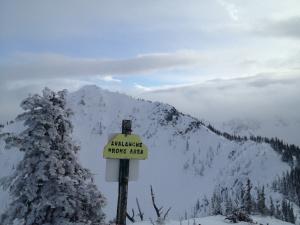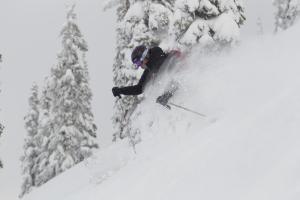As a ski patroller, I mitigate risk for a living. Whether on the edge of a groomer or the top of an avalanche path, my job is to reduce the risk for the skiing public. Perhaps that explains my fascination with the risk/reward calculus in action sports. What started a few months ago as a suggestion from a good friend, (“Hey Kim, maybe you should write your next book on risks, and why people take them!”) has transformed into an all-out obsession. My research has taken me from psychology to neurology to the stories of amazing athletes pushing themselves to the very edge. Now, everywhere I look, people are talking about risk. It is like the Baader-Meinhof Phenomenon, also known as the red-car phenomenon, when you encounter a previously obscure piece of information and start seeing it everywhere.

The light fading in Avalanche Basin
Friday, as I headed to the top of the King at the end of the day to sweep, I ran into a group of snowboarders preparing to drop into Avalanche Basin. Since it was the end of the day, and I was sweeping Southback, I explained to them that I would watch them all drop in and make sure they made it out the bottom before continuing on. None of them had ever skied Southback, and I observed their decision-making skills.
A few of them were tired from the hike and traverse. These ones were ready to drop-in and get to the bottom before it got dark. The best snowboarder of the group noticed the alpenglow surrounding Mt. Rainier. He seemed calm and prepared as he checked his line and smoothly dropped in. I asked the rest if they’d ever ridden this line. None of them had. I offered some beta on the various drop-in points, and waited for them to strap in. One of them laughed nervously. Another one seemed to obsessively check the screen of his POV camera, making sure it was on.
The visibility worsened as the sun disappeared behind a cloud. It would be totally dark in less than forty-five minutes. One by one the group dropped in. They waited carefully for each one to appear at the bottom of the chute and move to a safe location at the bottom.
Even though they appeared like newbies, they knew enough to go one at a time, to wear shovel packs and to check each area before dropping. As they prepared to to drop in, I watched them calculate the risk versus the reward. The rewards were big: three untracked chutes above an open fan with about 8″ of new snow. The risks, as always in the mountains, were many and varied. That 8″ of snow was sitting on a firm bed surface. Somewhere between the bed surface and the new snow was a layer of surface hoar. The visibility and the temperature were dropping. And now we had less than thirty minutes of daylight.

I love it when the rewards outweigh the risk
Three boarders remained. One, who I’d been following since the Throne saddle, waiting as he stumbled along the trail, expending twice as much energy as necessary, looked at me. His jacket was unzipped to his collar bone, and steam rose from his skin. “What’s below here?” He asked again. I explained the terrain carefully, then added, “this chute is the biggest. It’s the easiest way down.”
“The easiest way?”
I nodded, not that there is an easy way down Avalanche Basin, I pointed out. But of all the options, this one right here was the least risky.
He nodded and zipped up his jacket. I could see him doing the risk/reward calculus in his mind. He must have also considered his options. At this point, there weren’t many. It was too late to hike back out. To go any further would only mean he’d surely be riding out in the dark. It was now or never.
He was the last to drop in, and he carved a broad but respectable turn across the top of the chute. The snow rippled around his knees and sprayed onto his torso. It was a good thing he zipped up that jacket. I heard several whoops and hollers and continued my hike to the top of the King, glad I’d put fresh batteries in my headlamp.
Sometimes the rewards outweigh the risks. These are the good days, the lucky days, the days when six friends can end their day with one last run in Southback. But other times the risks are too high, and we hope we’ve built the judgment to know the difference. On those days, we back off. We stand further away from the cornice, we choose a safe line down. We exercise our judgment, which is the single-most important tool in the mountains.
A few minutes later, I stood on top of the King and attached my headlamp to my helmet. The gray light was fading fast. I hollered one last time into Silver Basin, “closing!” and listened to the wind. I was the only one out here. Everyone else had gone home. After a minute, I dropped in and glided home too.

